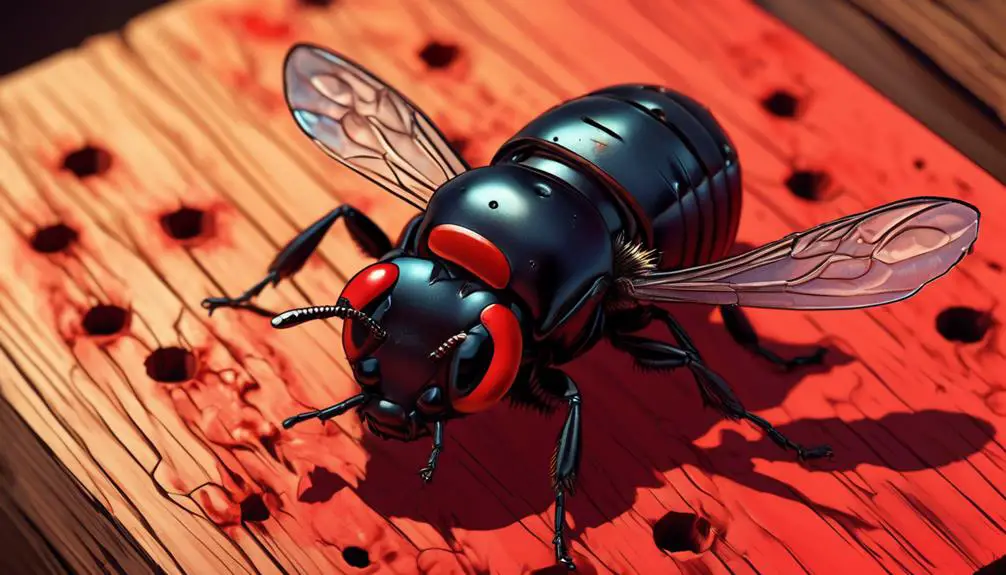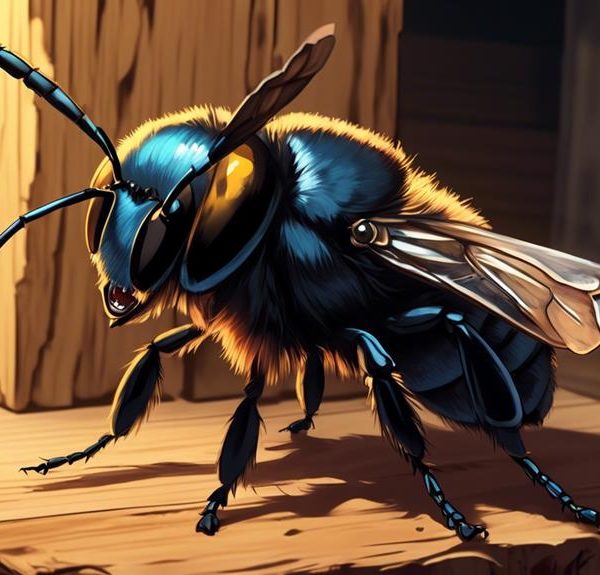Mystery surrounds carpenter bee stings, delve into their effects and learn what to do if you're stung in this insightful guide.

What Happens When a Carpenter Bee Stings You
Imagine you're enjoying a nice outdoor picnic when suddenly, a large, black and yellow insect hovers near your sandwich. It's a carpenter bee. While your first instinct might be to swat it away, you hesitate, remembering stories about their painful stings.
Now, you're probably wondering, 'What happens if it does sting me?' To ease your mind, let's set the record straight about carpenter bee stings, their potential effects, and what you should do if you're on the receiving end of one.
After all, knowing more about these creatures might just save you a lot of trouble down the line.
Key Takeaways
- Carpenter bees are solitary insects that bore into dead wood or bamboo to create nests.
- Female carpenter bees can sting, while males are stingless.
- Carpenter bees are not naturally aggressive and will only sting if provoked or cornered.
- Immediate symptoms of a carpenter bee sting include localized pain, redness, and swelling, but the sting is not life-threatening.
Understanding the Carpenter Bee

To fully grasp the nature of carpenter bee stings, it's crucial to first understand the carpenter bee itself. These creatures are unique among the bee species. Unlike honey bees or bumble bees, carpenter bees are solitary insects. They've a robust body that can range in size from half an inch to one inch in length, with a shiny, metallic-blue or greenish-black thorax.
Their abdomen, in contrast, appears black, smooth, and shiny. It's their peculiar nesting behavior that sets them apart. Rather than building hives, they bore into dead wood or bamboo, creating tunnels for nesting purposes. Here, the female lays her eggs, sealing each one off in a different cell with a supply of pollen and nectar.
You'll observe them in the warmer months, buzzing around wooden structures. They're often mistaken as aggressive due to their territorial behavior. But, they're generally non-aggressive, especially males, who lack a stinger. Yes, only female carpenter bees have stingers, and they'll use them only when they feel threatened.
As you delve deeper into this discussion, remember, understanding their behavior is key to comprehending the potential risks and impacts of their stings.
Sting or No Sting: The Truth

Let's debunk the myth: not all carpenter bees can sting. You may have heard stories of people getting stung by these buzzers, but in reality, only the females possess the capability to sting. Male carpenter bees are completely stingless. This is due to the sexual dimorphism present in the species, where the physical traits differ between the sexes.
Now, before you let out a sigh of relief, bear in mind that female carpenter bees aren't as pacifistic as their male counterparts. When provoked or threatened, they can and will sting. However, they're not naturally aggressive and generally won't bother you unless they feel cornered.
The sting of a carpenter bee isn't usually severe. It might be a bit painful, accompanied by local swelling and redness, similar to a common bee or wasp sting. However, if you're allergic to bee stings, the reaction could be more serious, occasionally leading to anaphylaxis.
The Immediate Aftermath of a Sting

If you're unfortunate enough to experience a carpenter bee sting, you'll notice immediate symptoms such as sharp, localized pain and a red, swollen area around the sting site. The sting of a carpenter bee isn't life-threatening, but it can be quite painful and discomforting. You'll feel a burning sensation at the sting site, and within a few minutes, a welt will start to form. The area may itch and remain swollen for several days.
Here's a table showing the immediate, short-term, and long-term symptoms of a carpenter bee sting:
Immediate | Short-term | Long-term | |
|---|---|---|---|
Pain | Sharp, localized | Dull, throbbing | Mild, intermittent |
Swelling | Yes | Decreases gradually | Minor, if any |
Other Symptoms | Redness, burning | Itchiness, welt | Possible scar |
If you're allergic to bee stings, the reaction could be more severe with symptoms like difficulty breathing, hives, or swelling of the face, throat, or mouth. In such cases, immediate medical attention is vital. Even if you're not allergic, it's important to clean the sting site with soap and water to prevent infection. Applying a cold pack can also help reduce swelling and pain.
Dealing With Carpenter Bee Stings

Having understood the immediate and potential consequences of a carpenter bee sting, it's crucial to learn effective ways to manage and treat the sting to alleviate pain and prevent complications.
Firstly, you should remove any stinger left behind. Use a flat-edged object to scrape across the sting site; tweezers can force more venom into the skin.
Next, clean the area thoroughly with soap and water to prevent infection. Application of a cold pack can reduce swelling and numb the area, providing immediate relief.
If you're dealing with persistent pain, over-the-counter pain relievers can be quite helpful. Antihistamines can also be used to counteract allergic reactions and reduce itching. Topical creams containing hydrocortisone may reduce inflammation and soothe the skin.
Despite these measures, if you experience severe symptoms like difficulty breathing, dizziness, or rapid heartbeat, seek immediate medical attention as you could be experiencing anaphylaxis, a severe allergic reaction.
Preventing Carpenter Bee Attacks

To prevent carpenter bee attacks, it's essential to understand their behavior, identify potential habitats around your home, and take effective preventive measures. Carpenter bees prefer to nest in soft, unpainted wood. Therefore, painting or staining your wood structures can deter them.
Moreover, the application of certain pesticides such as borate salts can provide a long-term solution. These salts penetrate deep into the wood, killing existing bees and deterring future ones. You should also seal any existing holes with steel wool and caulk to prevent the bees from returning.
Here's a quick guide on prevention:
Prevention Method | Description |
|---|---|
Paint or Stain Wood | Carpenter bees prefer untreated wood |
Apply Borate Salts | Pesticide that penetrates wood and kills bees |
Seal Existing Holes | Use steel wool and caulk to block entrances |
Regular Inspection | Spot potential habitats early |
Professional Help | Consult with pest control if infestation persists |
Conclusion
So, you've learned that carpenter bees can indeed sting, but it's typically the females that do so. If stung, you'll likely experience some pain, swelling, and redness.
It's crucial to clean the sting area promptly and monitor it for any severe allergic reactions.
You can deter these creatures from your surroundings using various preventive measures.
Ultimately, understanding carpenter bees and their behavior is the key to co-existing peacefully with them.


